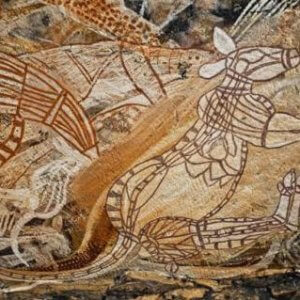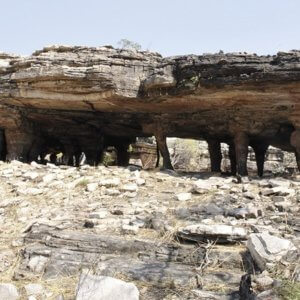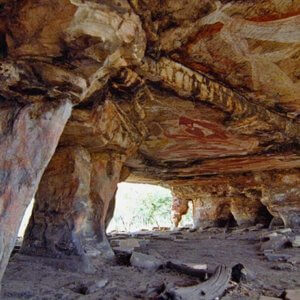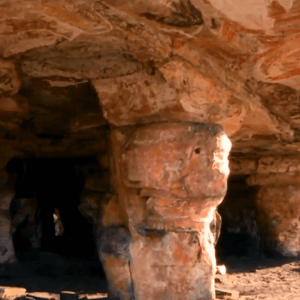
Is the stone monument in Nawarla Gabarnmung the oldest in the world?
 05. 04. 2019
05. 04. 2019

Much older than Stonehenge, even older than Gobekli Tepe of 9000 BC, older than Egyptian pyramids. There is no other older evidence of such a stone work than it is "Nawarla Gabarnmung" located in Arnhem County, Australia. Dating is about 50 000 BC. It is the oldest and most mysterious art stone work in the world.
Nawarla Gabarnmung
In Australia, in the county of Arhno, in its southwestern part, there is a stone work created by the indigenous people of Australia before 50 000 years ago. In the part of the country called Jawoyn lies Nawarla Gabarnmung. Here is an incredible technical example of a stone shelter that has ever been seen and was built in prehistoric times. We can imagine a hole in a rock, a passage or a valley open from its center, as the people of Jawoyn call it. They themselves protect it and it is a sacred place for them.
Margaret Katherine is currently responsible for Nawarla Gabarnmung. Only Jawoyn people can enter and study Gabarnmung this year. This passage monument, or transformed into a "hiding place", was hand-crafted by the skilled ancestors of the Jawoyn people, and is the oldest example that changes the view of stonework throughout the historical context. The lower charcoal found has an estimated age of about 49 350 BC
Interior of Nawarla Gabarnmung
The completion of the work at Gabarnmung did not require such precise mathematical knowledge as in the construction of the pyramids, but a certain degree of mathematical knowledge and intelligence in working with the stone had to be there because the work certainly continued for a long time. The shelter was built by tunneling into a naturally eroded cliff. The ceiling is at a height between 175 and 245 centimeters and is supported by 50 columns naturally formed in cracks in the bedrock, of which 36 columns were covered with paintings. Some of the pre-existing columns have been removed, others have been crafted, and others have been moved to another location.
In some places, the ceiling tiles were removed and painted by Jawoyny, who used the shelter. This "hole in the wall" contains a historical gallery of rock art and the oldest paintings in the world. The works of art in Gabarnmung compete with paintings in France and Spain with an 65 000 age. The importance of rock art in Gabarnmung lies in admirable details. These mysterious and interesting images demonstrate the experience of the Jawoyn artists.
Currently living people help to retell stories from these paintings and make them very topical. Many examples of rock paintings found across Australia during the last 200 years explain how the original inhabitants painted in the earliest times of human history. A few years ago, the Smithsonian wrote an article comparing the paintings in Gabarnmung.
There is no one to explain the paintings
If science has something to offer to Jawoyn, Jawoyns have something to offer to science. There is no one to explain the paintings in the Chauvet Cave in France. This is a place without memory, without life. But with the Gabarnmung complex we are lucky. There is a living culture, a living memory. Jawoyne can help us build new knowledge. Like the Sistine Chapel, the ceiling and the sandstone pillars of the vast hiding place in Gabarnmung are covered with breathtaking, lively art paintings.
- Nawarla Gabarnmung
- Nawarla Gabarnmung
- Nawarla Gabarnmung
- Nawarla Gabarnmung
Some of the found artifacts of the original rock art found in Australia are nowhere to be seen in the world. Thousands of rock art sites have been found across Australia for a long time. (There is more rock art in Australia than in the rest of the world). Nawarla Gabarnmung also includes extinct megafauna images.
The Flying Bird Genyornis newtoni
An important example is the image of the giant flightless bird "Genyornis newtoni". He was taller than an adult man and probably died out before 45 000 years ago, and Jawoyn's ancestors perfectly portrayed him on their rock painting. This depiction of the megafauna thus gives us the time in which the ancestors of the indigenous peoples of Arnhem lived. With all these discoveries, we have a very solid way to calibrate the radiocarbon method from 13 to 000 years into our past, even though we only have a data fragment. Thanks to the very important historical records left by the original Australian inhabitants of prehistoric times, we can work better with the dating of long past events.
Nawarla Gabarnmung is the oldest known example of transforming a hiding place into a monument. It was created by the hands of Jawoyn's ancestors. We can call it 50 000 years old stonework engineers. Perhaps it is not the oldest stonework in the world, but it can certainly be said that the original Australians are the only group of people in the history of mankind that we can call stone engineers. Comparing with other major world monuments, Gabarnmung clearly stands out from them and the contribution of the indigenous peoples of Australia to the history of mankind must be underlined.





 1
1




